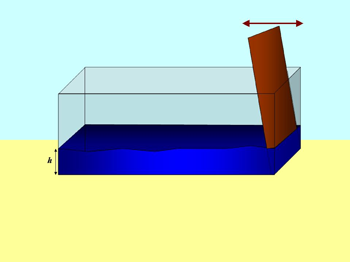Wave Generation and Properties
Materials:
- Rectangular aquarium (a 10 or 20 gallon aquarium will work, though a larger aquarium will make it easier to measure the waves)
- Water
- Food coloring
- Syringe
- Rectangular board, as wide as the narrow edge of the aquarium and longer than the height of the aquarium (see diagram below).
- Ruler

Method:
- Pour water in the aquarium up to a height (or depth) h. Use the board to make waves by gently moving it back and forth while maintaining it fixed at the bottom (see diagram).
-
- Try to measure the wavelength and the period T of the waves generated. Make sure you measure the wavelength and period before the waves hit the other side of the aquarium.
- Calculate the wave celerity C with the values wavelength and period that you measured.
- Can you tell whether the waves produced are shallow (long) or deep (short)?
- Compare the speed C to the theoretical value for shallow or deep waves.
- Now compare your results to those obtained at: http://www.coastal.udel.edu/faculty/rad/wavemaker.html
- Different waves. Add more water and measure the new h. Do steps a) through e) above and compare results.
- Particle trajectories. With the syringe, add a small amount of food coloring. Then look at the orbital trajectories of the food coloring and determine whether they are circular (deep wave) or elliptical (shallow wave). Experiment further at http://www.coastal.udel.edu/faculty/rad/linearplot.html with different wave configurations and look at the orbital trajectories under waves.
- Using your aquarium, how would you determine the wave height/depth ratio at which waves break? Add a sloping board at the bottom of the tank. Experiment with different h and different speeds of paddle oscillations to see at what values of the ratio H/h the waves start to break.
- Wave superposition Go to the site: http://www.coastal.udel.edu/faculty/rad/superplot.html and experiment with various waves to see the result of their superposition.
-
Tsunamis
- What is the speed of a tsunami traveling in the middle of the Atlantic Ocean over a depth of 3000 m? If it is generated off the coast of the Azores Islands, 5000 kilometers away from Florida, how long will it take for the tsunami to arrive in Florida?
-
Tides
- How long does it take for the tide to propagate in Tampa Bay from Port Manatee to McKay Bay Entrance? These two sites are 36 km apart, and we can assume that the tidal wave travels over a mean depth of 10 m. Verify your answer with real tide data from: http://tidesandcurrents.noaa.gov/